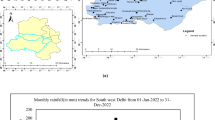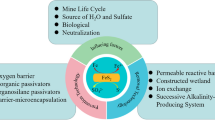Abstract
Uranium was extracted in the Königstein uranium mine by in-situ leaching with sulfuric acid until 1990. The originally anoxic conditions in the ore body became oxic due to the leaching process and the dewatering of the mine workings. Under these conditions, acid and metals continue to be mobilized. A field test was performed on how to restore reductive conditions in an area of the mine workings with low flow velocities. The aim was to test the immobilisation of contaminants as a prerequisite for further flooding of the mine. The field test showed that it is possible to re-establish and maintain rather reductive geochemical in-situ-conditions, which is necessary to precipitate sulphides as well as reduce acidity and metal concentrations.
Zusammenfassung
Im Uranbergwerk Königstein wurde bis 1990 Uran durch in-situ Laugung mit Schwefelsäure gewonnen. Die ursprünglich anoxischen Verhältnisse im Erzkörper wurden durch den Laugungsprozess und die Grubenwasserhaltung oxisch. Unter diesen Bedingungen werden weiterhin Säure und Metalle mobilisiert. In einem Feldversuch wurde untersucht, wie die reduktiven Bedingungen in einem Bereich des Grubengebäudes mit geringen Fließgeschwindigkeiten wiederhergestellt werden können. Ziel war es dabei, die Immobilisierung von Schadstoffen als Voraussetzung für eine weitere Flutung der Grube zu testen. Der Feldversuch hat gezeigt, dass es möglich ist, reduktive geochemische in-situ-Bedingungen wiederherzustellen und aufrechtzuerhalten, wie sie für die Ausfällung von Sulfiden und die Verringerung des Säuregehalts und der Metallkonzentrationen erforderlich sind.












Similar content being viewed by others

Data availability
The data was collected as part of the field test described in the paper on behalf of Wismut GmbH. The data are the property of Wismut GmbH. Inquiries in this regard can be directed to the company.
References
Bigham JM, Nordstrom DK (2000) Iron and aluminum hydroxysulphates from acid sulphate waters. In: Alpers CN, Jambor JL, Nordstrom DK (eds) Sulphate minerals-crystallography, geochemistry, and environmental significance: reviews in mineralogy & geochemistry, vol 40. Mineralogical Soc of America. Washington, DC, pp 351–404
Bilek F, Hache M, Jenk U (2019) Long-term experiments to control the environmental conditions in the Königstein mine: possible measures to establish a self-regulating, hydrogeochemically stable and near-natural condition. Proc, International Mine Symp,. Shaping the Future: Long-term Experiences and Innovations in Mine Remediation WISSYM, Chemnitz, pp 215–223 [in German]
Dos Santos AM, Stumm W (1992) The reductive dissolution of iron(III)-(hydr)oxides by hydrogen sulfide. Langmuir 8:1671–1675. https://doi.org/10.1021/la00042a030
Elliot P, Ragusa S, Catcheside D (1998) Growth of sulphate-reducing bacteria under acidic conditions in an upflow anaerobic bioreactor as a treatment system for acid mine drainage. Water Res 32:3724–3730
Giese R, Hache M (2016) Two-stage in-situ biostimulation for aftercare of a partial source decontamination as LNAPL elimination (EOR)- results of a pilot remediation at the abandoned industrial site. Proc, Altlastensymposium, pp 146–147 [in German]. https://www.itv-altlasten.de/altlastensymposium/altlastensymposium-1991-2019/
Jenk U, Ziegenbalg G (2006) The use of BaSO4 supersaturated solutions for in-situ immobilization of heavy metals in the abandoned Wismut GmbH uranium mine at Koenigstein. Uranium in the Environment. Springer-Verlag, Berlin, Mining Impact and Consequences, pp 721–727
Jenk U, Schreyer J, Klinger C (2003) Fe(0)/lignitic coal: an efficient and mechanically stable reactive material for purification of water containing heavy metals, radionuclides, and nitroaromatics. Environ Sci Technol 37:644–651
Jenk U, Zimmermann U, Uhlig U, Schöpke R (2014a) In situ mine water treatment: field experiment at the flooded Königstein uranium mine (Germany). Mine Water Environ 33:39–47
Jenk U, Luckner L (1998) Findings from the flooding experiments at 33.4 and 40.0 m above sea level in the Königstein mine. In: Merkel B, Helling C (Eds), Uranium-Mining and Hydrogeology II, Proc, International Conf and Workshop, von Loga, Köln [in German]
Jenk U, Frenzel M, Metschies T, Paul M (2014b) Flooding of the underground uranium leach operation at Königstein (Germany) – A multidisciplinary report. Proceedings of International Mine Water Association Congress, Xuzhou, China, 715–719
Jong T, Parry DL (2006) Microbial sulphate reduction under sequentially acidic conditions in an upflow anaerobic packed bed bioreactor. Water Res 40:2561–2571
Kaksonen AH, Puhakka JA (2007) Sulphate reduction based bioprocesses for the treatment of acid mine drainage and recovery of metals. Eng Life Sci 7(6):541–564
Merkel B, Helling C (Eds) (1998) Uranium-Mining and Hydrogeology II Proc, International Conf and Workshop, International Atomic Energy Agency, Vienna
Peiffer S (1994) Reaction of H2S with ferric oxides – some conceptual ideas on its significance for sediment-water interactions in environmental chemistry of lakes and reservoirs. In: Baker LA (ed) Environmental Chemistry of Lakes and Reservoirs, American Chemical Society. American Chemical Society, Washington, pp 371–390
Pytzik AJ, Sommer SE (1981) Sedimentary iron monosulfides: kinetics and mechanism of formation. Geochim Cosmochim Acta 45:687–698
Walko M, Hildmann C (2018) Microbially induced iron retention in the groundwater upstream of post-mining lakes and rivers at the Ruhlmühle site. Final report on behalf of the LMBV, Germany ([in German])
Widdel F (1988) Microbiology and ecology of sulphate- and sulfur-reducing bacteria, In: Zehnder AJG (Ed), Biology of Anaerobic Microorganisms, John Wiley & Sons, New York City
Author information
Authors and Affiliations
Corresponding author
Rights and permissions
Springer Nature or its licensor (e.g. a society or other partner) holds exclusive rights to this article under a publishing agreement with the author(s) or other rightsholder(s); author self-archiving of the accepted manuscript version of this article is solely governed by the terms of such publishing agreement and applicable law.
About this article
Cite this article
Jenk, U., Kleditz, N., Bilek, F. et al. Field Test to Restore Original Geochemical Conditions in a Flooded Mine Area-An Essential Milestone for the Complete Remediation of the Königstein Uranium Mine. Mine Water Environ 42, 50–58 (2023). https://doi.org/10.1007/s10230-023-00927-5
Received:
Accepted:
Published:
Issue Date:
DOI: https://doi.org/10.1007/s10230-023-00927-5



